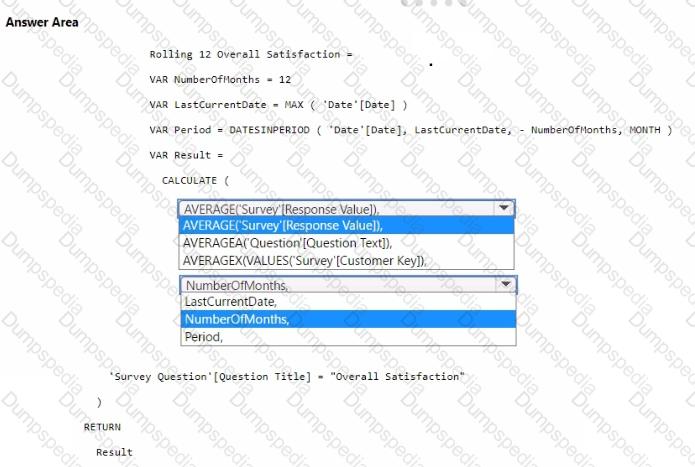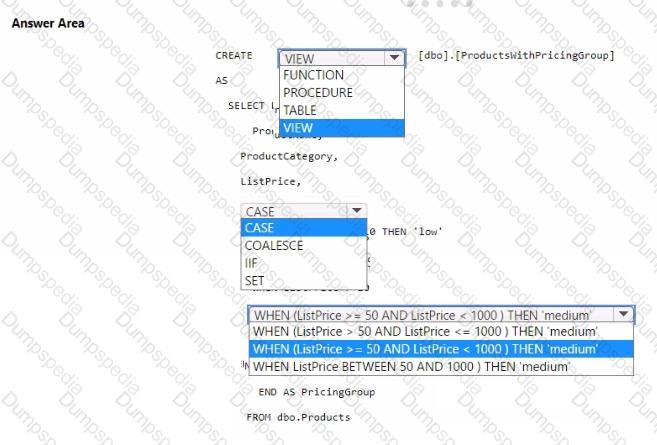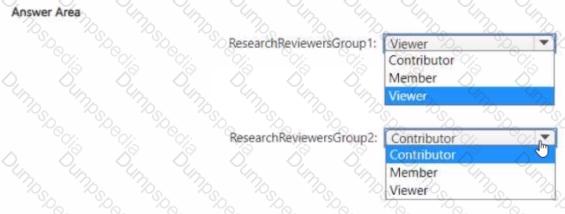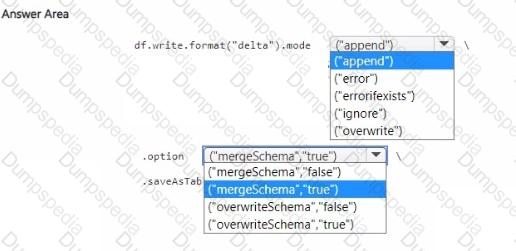You need to create a DAX measure to calculate the average overall satisfaction score.
How should you complete the DAX code? To answer, select the appropriate options in the answer area.
NOTE: Each correct selection is worth one point.


What should you recommend using to ingest the customer data into the data store in the AnatyticsPOC workspace?
You need to ensure the data loading activities in the AnalyticsPOC workspace are executed in the appropriate sequence. The solution must meet the technical requirements.
What should you do?
You need to resolve the issue with the pricing group classification.
How should you complete the T-SQL statement? To answer, select the appropriate options in the answer area.
NOTE: Each correct selection is worth one point.


You need to recommend a solution to group the Research division workspaces.
What should you include in the recommendation? To answer, select the appropriate options in the answer area.
NOTE: Each correct selection is worth one point.

Which workspace rote assignments should you recommend for ResearchReviewersGroupl and ResearchReviewersGroupZ? To answer, select the appropriate options in the answer area.
NOTE: Each correct selection is worth one point.

You need to refresh the Orders table of the Online Sales department. The solution must meet the semantic model requirements. What should you include in the solution?
What should you use to implement calculation groups for the Research division semantic models?
You need to ensure that Contoso can use version control to meet the data analytics requirements and the general requirements. What should you do?
You need to recommend which type of fabric capacity SKU meets the data analytics requirements for the Research division. What should you recommend?
You need to migrate the Research division data for Productline2. The solution must meet the data preparation requirements. How should you complete the code? To answer, select the appropriate options in the answer area
NOTE: Each correct selection is worth one point.

Which syntax should you use in a notebook to access the Research division data for Productlinel?
A)

B)

C)

D)

You have a Fabric tenant that contains a workspace named Workspace1. Workspace1 uses Pro license mode and contains a semantic model named Model1. You need to ensure that Modell supports XMLA connections. Which setting should you modify?
NO: 76
Note: This question is part of a series of questions that present the same scenario. Each question in the series contains a unique solution that might meet the stated goals. Some question sets might have more than one correct solution, while others might not have a correct solution.
After you answer a question in this section, you will NOT be able to return to it. As a result, these questions will not appear in the review screen.
You have a Fabric tenant that contains a lakehouse named Lakehousel. Lakehousel contains a Delta table named Customer.
When you query Customer, you discover that the query is slow to execute. You suspect that maintenance was NOT performed on the table.
You need to identify whether maintenance tasks were performed on Customer.
Solution: You run the following Spark SQL statement:
DESCRIBE DETAIL customer
Does this meet the goal?
You have a Fabric tenant
You are creating a Fabric Data Factory pipeline.
You have a stored procedure that returns the number of active customers and their average sales for the current month.
You need to add an activity that will execute the stored procedure in a warehouse. The returned values must be available to the downstream activities of the pipeline.
Which type of activity should you add?
You have a Fabric workspace named Workspace1.
You need to create a semantic model named Model1 and publish Model1 to Workspace1. The solution must meet the following requirements:
Can revert to previous versions of Model1 as required.
Identifies differences between saved versions of Model1.
Uses Microsoft Power BI Desktop to publish to Workspace1.
Can edit item definition files by using Microsoft Visual Studio Code.
Which two actions should you perform? Each correct answer presents part of the solution.
NOTE: Each correct selection is worth one point.
You have a Fabric tenant that contains a new semantic model in OneLake.
You use a Fabric notebook to read the data into a Spark DataFrame.
You need to evaluate the data to calculate the min, max, mean, and standard deviation values for all the string and numeric columns.
Solution: You use the following PySpark expression:
df.show()
Does this meet the goal?
You have a Fabric tenant tha1 contains a takehouse named Lakehouse1. Lakehouse1 contains a Delta table named Customer.
When you query Customer, you discover that the query is slow to execute. You suspect that maintenance was NOT performed on the table.
You need to identify whether maintenance tasks were performed on Customer.
Solution: You run the following Spark SQL statement:
REFRESH TABLE customer
Does this meet the goal?
You need to implement the date dimension in the data store. The solution must meet the technical requirements.
What are two ways to achieve the goal? Each correct answer presents a complete solution.
NOTE: Each correct selection is worth one point.
You have a Microsoft Fabric tenant that contains a dataflow.
You are exploring a new semantic model.
From Power Query, you need to view column information as shown in the following exhibit.

Which three Data view options should you select? Each correct answer presents part of the solution. NOTE: Each correct answer is worth one point.
You have a Fabric tenant that contains lakehouse named Lakehousel. Lakehousel contains a Delta table with eight columns. You receive new data that contains the same eight columns and two additional columns.
You create a Spark DataFrame and assign the DataFrame to a variable named df. The DataFrame contains the new data. You need to add the new data to the Delta table to meet the following requirements:
• Keep all the existing rows.
• Ensure that all the new data is added to the table.
How should you complete the code? To answer, select the appropriate options in the answer area.

You have a Fabric tenant that contains a lakehouse named Lakehouse! Lakehouse1 contains a Delta table that has one million Parquet files.
You need to remove files that were NOT referenced by the table during the past 30 days. The solution must ensure that the transaction log remains consistent, and the ACID properties of the table are maintained
What should you do?
You have a Fabric tenant that contains a semantic model. The model contains data about retail stores.
You need to write a DAX query that will be executed by using the XMLA endpoint. The query must return the total amount of sales from the same period last year.
How should you complete the DAX expression? To answer, select the appropriate options in the answer area. NOTE: Each correct selection is worth one point.

Note: This section contains one or more sets of questions with the same scenario and problem. Each question presents a unique solution to the problem. You must determine whether the solution meets the stated goals. More than one solution in the set might solve the problem. It is also possible that none of the solutions in the set solve the problem.
After you answer a question in this section, you will NOT be able to return. As a result, these questions do not appear on the Review Screen.
Your network contains an on-premises Active Directory Domain Services (AD DS) domain named contoso.com that syncs with a Microsoft Entra tenant by using Microsoft Entra Connect.
You have a Fabric tenant that contains a semantic model.
You enable dynamic row-level security (RLS) for the mode! and deploy the model to the Fabric service.
You query a measure that includes the username () function, and the query returns a blank result.
You need to ensure that the measure returns the user principal name (UPNJ of a user.
Solution: You add user objects to the list of synced objects in Microsoft Entra Connect.
Does this meet the goal?
You have source data in a CSV file that has the following fields:
• SalesTra nsactionl D
• SaleDate
• CustomerCode
• CustomerName
• CustomerAddress
• ProductCode
• ProductName
• Quantity
• UnitPrice
You plan to implement a star schema for the tables in WH1. Thedimension tables in WH1 will implement Type 2 slowly changing dimension (SCD) logic.
You need to design the tables that will be used for sales transaction analysis and load the source data.
Which type of target table should you specify for the CustomerName, CustomerCode, and SaleDate fields? To answer, select the appropriate options in the answer area.
NOTE: Each correct selection is worth one point.
CC
You have a Fabric workspace that uses the default Spark starter pool and runtime version 1,2.
You plan to read a CSV file named Sales.raw.csv in a lakehouse, select columns, and save the data as a Delta table to the managed area of the lakehouse. Sales_raw.csv contains 12 columns.
You have the following code.

For each of the following statements, select Yes if the statement is true. Otherwise, select No. NOTE: Each correct selection is worth one point.

You have a Fabric warehouse that contains a table named Staging.Sales. Staging.Sales contains the following columns.

You need to write a T-SQL query that will return data for the year 2023 that displays ProductID and ProductName arxl has a summarized Amount that is higher than 10,000. Which query should you use?
A)

B)

C)

D)

You have a Fabric tenant that contains a semantic model. The model uses Direct Lake mode.
You suspect that some DAX queries load unnecessary columns into memory.
You need to identify the frequently used columns that are loaded into memory.
What are two ways to achieve the goal? Each correct answer presents a complete solution.
NOTE: Each correct answer is worth one point.
You have a Fabric tenant that contains a new semantic model in OneLake.
You use a Fabric notebook to read the data into a Spark DataFrame.
You need to evaluate the data to calculate the min, max, mean, and standard deviation values for all the string and numeric columns.
Solution: You use the following PySpark expression:
df .sumary ()
Does this meet the goal?
You have a Fabric tenant that contains a workspace named Workspace1. Workspace1 contains a single semantic model that has two Microsoft Power BI reports.
You have a Microsoft 365 subscription that contains a data loss prevention (DLP) policy named DLP1.
You need to apply DLP1 to the items in Workspace1.
What should you do?